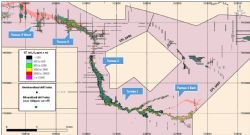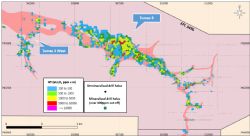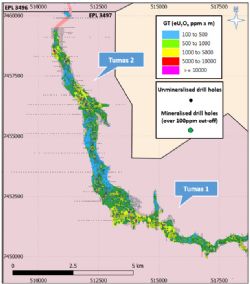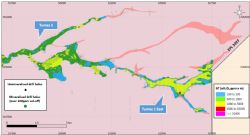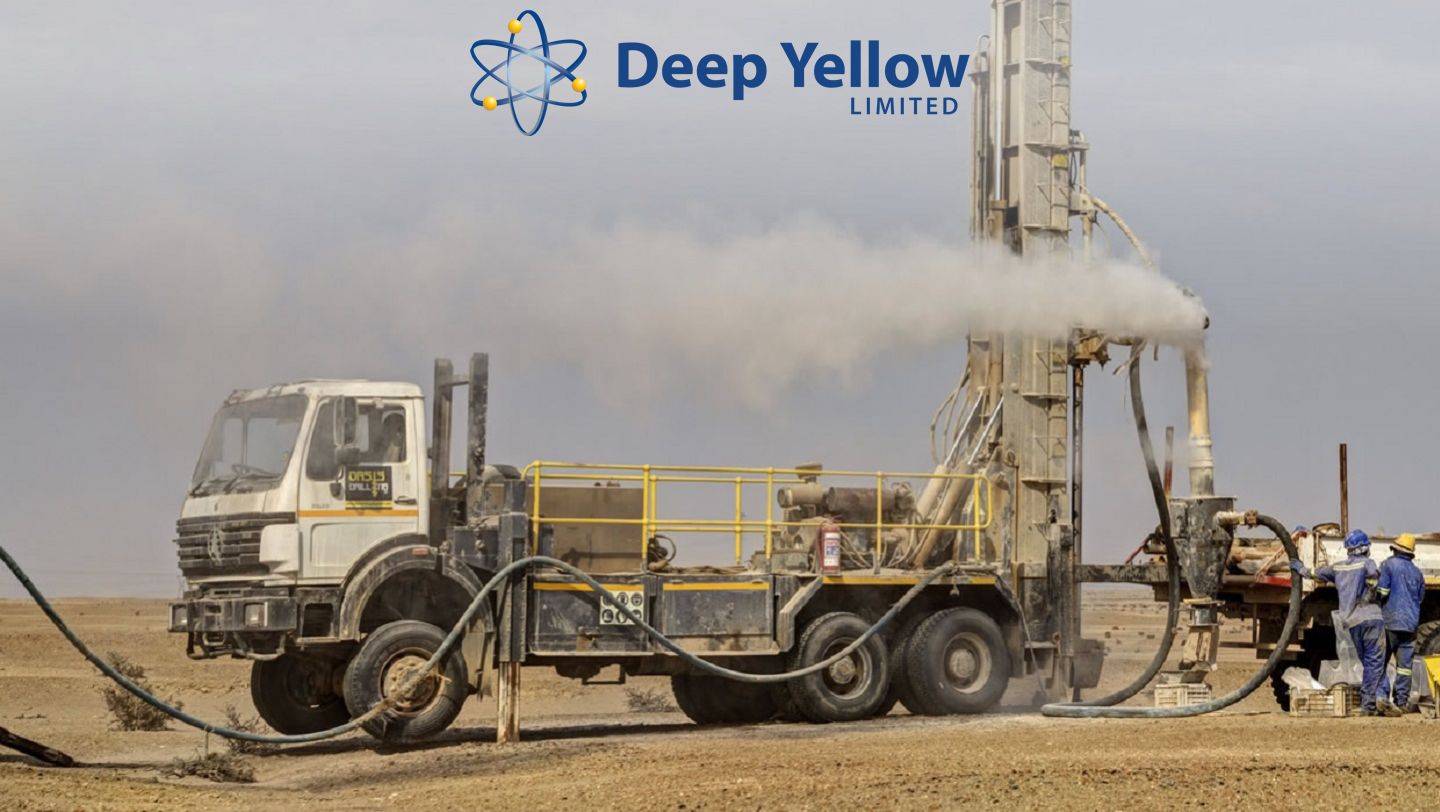
Uranium Resources Expanded by 51% - Tumas 1, 2 & 3 Deposits
Perth, Mar 27, 2019 AEST (ABN Newswire) - Deep Yellow Limited ( ASX:DYL) (
ASX:DYL) ( DYLLF:OTCMKTS) (Deep Yellow) is pleased to announce an updated Mineral Resource Estimate (MRE) for the Tumas 1, 2 and 3 deposits which, at a 200ppm eU3O8 cut-off now contains 67.4Mlb of Measured, Indicated and Inferred Mineral Resources at 352ppm eU3O8. This represents an increase of 51% from the MRE announced to the ASX on 11 July 2018. These deposits occur on EPLs 3496 and 3497, held by the Deep Yellow wholly-owned subsidiary, Reptile Uranium Namibia (Pty) Ltd. The MRE was undertaken using various cut-off grades using a minimum thickness of 1m and conforms to the 2012 JORC Code of Mineral Resource Reporting.
DYLLF:OTCMKTS) (Deep Yellow) is pleased to announce an updated Mineral Resource Estimate (MRE) for the Tumas 1, 2 and 3 deposits which, at a 200ppm eU3O8 cut-off now contains 67.4Mlb of Measured, Indicated and Inferred Mineral Resources at 352ppm eU3O8. This represents an increase of 51% from the MRE announced to the ASX on 11 July 2018. These deposits occur on EPLs 3496 and 3497, held by the Deep Yellow wholly-owned subsidiary, Reptile Uranium Namibia (Pty) Ltd. The MRE was undertaken using various cut-off grades using a minimum thickness of 1m and conforms to the 2012 JORC Code of Mineral Resource Reporting.
HIGHLIGHTS
- Resource extension and infill drilling at Tumas 1 and 2, Tumas 1 East and Tumas 3 West has produced a combined Measured, Indicated and Inferred Mineral Resource Estimate in this area of 67.4Mlb grading 352ppm eU3O8.
o A notable 51% resource growth achieved on these deposits while maintaining the average grade.
- Resources within the Tumas palaeochannel system now 86.2Mlb at 310 ppm eU3O8 (close to three-fold increase since November 2016).
- Overall palaeochannel-related Mineral Resources have been doubled since November 2016 and are now 104.2Mlb grading 295ppm eU3O8.
- Current drilling indicates the system remains open west of Tumas 3 and drilling of Tributaries 4 and 5 at Tumas 1 East showing encouraging results delineating another zone of continuous uranium mineralisation
- 60km of uranium-fertile palaeochannels remain to be properly tested offering highly prospective targets.
o The excellent progress to date continues to advance the project toward achieving its stated calcrete Mineral Resource target.
- Mineralisation is calcrete-associated and hosted in palaeochannels, similar to the Langer Heinrich uranium mine located 30km to the north-east.
A four-month resource extension RC drilling program was completed in December 2018, testing areas immediately east of the Tumas 1 deposit and west of Tumas 3 deposit (see Figure 1 in link below). This work also included some limited infill drilling within the Tumas 1 and 2 deposits. Drilling extended the mineralised Tumas paleochannel system in this area by 8.4km and delineated extensive uranium mineralisation therein. Of the 346 RC holes drilled for 5,599m during this campaign, 221 holes returned positive results - an overall 64% success rate.
This addition to the Tumas palaeochannel uranium resource base has increased the Company's total surficial calcrete-related Mineral Resources over its Namibian projects by a significant 28%. Importantly, since the new exploration approach was applied from November 2016, the overall palaeochannel-hosted resources have been doubled over its Namibian projects totalling 104.2Mlb U308. This is fully vindicating the change of focus that was made which identified the extensive, regionally occurring prospective palaeochannel thus expanding the exploration target significantly.
The uranium mineralisation that has been defined to date in the Tumas palaeochannel system occurs as three distinct mineralised bodies. These are the Tumas 1 and 2 deposits, now including the Tumas 1 East tributary extensions, the Tumas 3 deposit and the Tubas Red Sands/calcrete deposits (see Figure 1 in link below). The Tumas 1, 2 and 3 deposit expansions and the associated new MRE are the subject of this announcement. The combined overall Tumas palaeochannel resource now totals 86.2Mlb eU3O8 at 310ppm over EPLs 3496/97.
The high prospectivity of the palaeochannels in this region is continuing to be strongly confirmed with each drilling episode that has been undertaken. The channels occurring outside the identified deposits have only in part, been sparsely drilled by previous workers using widely spaced regional lines and large sections remain completely untested leaving much opportunity to continue increasing the uranium resource base with further drilling.
Exploration Target
As previously reported Deep Yellow has identified 125km of highly prospective palaeochannel systems of which only 65km have been adequately tested leaving much opportunity to continue increasing the uranium resource base with further drilling.
Over the last 2 years exploration and resource drilling mainly concentrated in the eastern and central parts of the Tumas palaeochannel system. This work has been highly successful producing a cumulative 86.2Mlb eU3O8 at 310ppm associated with this Reptile Project palaeochannel. With this latest addition to its resource base the Company has notably increased its calcrete-associated uranium resources and with each drilling campaign is approaching closer to its stated total Exploration Target(see Note below) of 100M to 150Mlb at a grade range of 300ppm to 500ppm for this type of uranium mineralisation. Deep Yellow's total JORC conforming uranium Mineral Resources on its Namibian projects are shown in Appendix 1(see link below).
Note: With the additional resources as announced herein, the Company has now determined an MRE of 104Mlb of calcrete mineralisation - reaching the lower of its stated Exploration Target range of 100M to 150Mlb eU3O8. The Company however acknowledges that the potential quantity and grade of the Exploration Target is conceptual in nature. There is however significant and sufficient additional exploration information generated to give more confidence that the Exploration Target has improved the chance to achieve the stated expanded Mineral Resource objective. Additional exploration is planned; however, it is uncertain if this will result in the estimation of all the expanded Mineral Resource that has been predicted from the review and evaluation of calcrete associated mineralisation identified on the Company's tenements which commenced in the December 2017 Quarter. With the subsequent exploration and resource drilling carried out over the past two years, the Company has a greater understanding of the stratigraphy and topography of the palaeochannels which host the uranium mineralisation. This work and the resource increase that is being achieved has provided renewed confidence that further mineralisation is likely to be identified in targeted palaeochannel areas on the Company's tenements.
Targeted tonnage/grades are based on results and understanding from work carried out over past 12 years in this region and the Exploration Targets that have been defined will continue to be the focus the ongoing drilling investigations.
Tumas 1, 2 and 3 Mineral Resource Estimate Summary
Exploration and infill resource drilling carried out in conjunction with geological studies in 2017 and 2018 have substantially improved the Company's understanding of the palaeochannel-associated calcrete-type targets and its uranium mineralisation. The new MRE over the Tumas 1, 2 and 3 deposits, incorporating their western and eastern extensions and including the newly discovered tributaries, is the result of the positive July to December 2018 drilling program and re-interpretation of the relevant historic drill data.
The MRE was estimated by Ordinary Kriging. Cut-off grades used for the expanded MRE included 100, 150, 200, and 250 ppm eU3O8 and the Measured, Indicated and Inferred Mineral Resources derived from these cut-off grades indicate the mineralisation remains robust and consistent. Table 1 (see link below) shows the MRE results at various cut-offs and Table 2 (see link below) shows the MRE results at a 200 ppm eU3O8 cut-off in comparison to the previous resource estimation.
The combined MRE for the extended Tumas 1, 2 and 3 deposits at a 200ppm cut-off gives a combined Measured, Indicated and Inferred Mineral Resource of 67.4Mlb at 352ppm eU3O8 as shown in in Table 1 (see link below). The 200ppm eU3O8 cut-off has been selected as being the most appropriate for headline reporting of the resource estimations. When the Tubas Red Sands/Calcrete and the Aussinanis deposits are included, this amounts to 104.2Mlb for all the palaeochannel-associated targets.
ASX Additional Information
The following is a summary of the material information used to estimate the Mineral Resources as required by Listing Rule 5.8.1 and JORC 2012 Reporting Guidelines
Deposit Parameters: The Tumas 1, 2 and 3 uranium deposits are of the calcrete-hosted type, located within an extensive regionally-occurring mainly east-west and north/west-south/east trending palaeochannel system. The uranium mineralisation occurs in conjunction with calcium carbonate precipitations (calcrete) in sediment filled palaeovalleys. Uranium is the only economically extractable metal in this type of mineralisation although vanadium production can be considered if the price for vanadium becomes sufficiently attractive. Uranium minerals mainly include uranium vanadates. The geology of this type of mineralisation is well understood having been explored over many years. The Langer Heinrich uranium mine located 30km to the north-east exploits this type of deposit and has been mined since 2007.
The mineralisation domains used for the current extended MRE study were interpreted to capture continuous zones of mineralisation above 100ppm eU3O8. The mineralisation included in this study has a strike length of approximately 38km and ranges in width from 100m to 900m, extending to a depth of 40 to 50m averaging around 15m below surface along the main Tumas channel. This includes the 8km of mineralisation encountered along four tributary channels. The mineralisation occurs in a reasonably continuous, seam-like horizon and is interpreted to extend west beyond the currently drilled area. The main channel is closed off at the eastern end however some tributary channels found in this area remain to be tested.
Drilling for the project was based on RC methods only. Drill holes used in the Mineral Resource Estimation included 1,330 holes totalling 31,861m drilled in 2017 and 2018 and 7,402 historical drill holes totalling 131,531m drilled by Deep Yellow between 2006 and 2012. Drilling achieved sample recoveries of around 90%. All drill chips were geologically logged, and their radioactivity was measured downhole. All data were added to the verified database.
The 2017 and 2018 drilling programs were carried out on a spacing of 100m by 100m. At Tumas 1 East where the continuity of the uranium mineralisation along the channel was very good, a drill density of 200m by 100m was deemed sufficient to define an Inferred Resource. Around some tributary palaeochannels drill spacing was reduced to 50m x 50m if required. Pre-2017, exploration drilling carried out by the Company was along regional 2km spaced drill lines with holes spaced 50m apart along these lines. Previous resource drilling done in the pre-2017 period had hole spacings varying from 50m by 50m to 25m by 25m enabling the definition also of Measured and Indicated Resource categories.
Methodology: Data used in the MRE is largely based on down-hole radiometric gamma logging taken by a fully calibrated Aus Log gamma logging system which was used in the recent and previous drilling programs. Down-hole gamma readings were taken at 5cm intervals and converted into equivalent uranium values (eU3O8) before being combined to 1m intervals. Geochemical assays were collected from 1m RC-drilling intervals, which were split to 1 to 1.5kg samples by riffle splitters. 120gm were further pulverised for use in regular XRF determinations and ICP-MS check analysis work. In the 2017 and 2018 programs,1 in 10 uranium intersections were tested by XRF analysis. Selected samples from the historical holes were also check-assayed for U3O8 by ICP-MS method to confirm the previous XRF results. For further description of sampling techniques and associated data see Appendix 2 Table 1 (see link below)
The geochemical assays were used to confirm the validity of the eU3O8 values determined by downhole gamma probing. After validation, the eU3O8 values derived from the down-hole gamma logging were given preference over geochemical assays for the Mineral Resource Estimation.
The relevant drill hole details and results were previously reported by Deep Yellow in announcements made to the ASX on 5 July 2018, 17 April 2018, 14 December 2017, 27 September 2017, 11 July 2017, 22 June 2017, 22 May 2017, 19 April 2017 and 25 October 2016.
Figure 2 (see link below) shows the Tumas 1, 2 and 3 deposit drill hole locations with drill hole collars coloured according to their grade thickness (GT- eU3O8ppm x metre thickness). Figures 3, 4 and 5 (see link below) show contour maps of grade thickness (GT- eU3O8ppm x metre thickness) of the Tumas 1, 2 and 3 mineralisation outlining the extent and nature of the mineralisation over the 38km length of channel tested and include the 8km of mineralised tributary channels that have been identified. Crosssections through the three deposits are shown in Figures 6 ,7 ,8 ,9 and 10 (see link below).
Prospectivity, High Potential and Future Drilling
The ongoing drilling of the Tumas palaeochannel continues to prove highly successful, fully endorsing the new approach that has been taken to test this very prospective regional target area identified. This work continues to add substantial new uranium resources at Tumas 1, 2 and 3 with each resource drilling campaign that has been undertaken. Additionally, the investigations and exploration drilling during this current program have identified extensive untested palaeochannels that are considered very prospective.
The 67.4Mlb now attributable to Tumas 1, 2 and 3 translates to 1.8Mlb/km for the 38km over which these deposits occur. The 86.2Mlb of Measured, Indicated and Inferred Mineral Resources now attained from the Reptile Project palaeochannels represent a remarkable 167% increase in the calcrete resource base on this project since the new-focus investigations commenced. Deep Yellow is now very close to the first major milestone of 100Mlb eU3O8. from the Tumas palaeochannel alone.
As has been previously stated, work is clearly confirming that increasing the palaeochannel calcrete resource base toward the range of 100M-150Mlb uranium resources in the 300 to 500ppm U3O8 grade range is considered as a realistic objective with Tumas 3 remaining open to the immediate west and a further 60km of palaeochannel identified still to be tested.
This strongly justifies the need to continue exploration and systemically drill-test the underexplored palaeochannel systems that remain contained in the Company's 100% owned tenements, EPLs 3496 and 3497.
The current drilling program commenced as announced on 4 March. Work is ongoing testing both the western extension of the Tumas 3 resource and additional tributaries north-east of Tumas 1. This drilling program is planned to be completed by late April with results reported in early May.
Exploration Efficiency
Since the new management started overseeing the Deep Yellow exploration effort, 54.1Mlb of Inferred U3O8 Resources have been added to the uranium inventory of the Reptile Project. This was achieved by concentrating the exploration effort on calcrete-associated uranium mineralisation within the eastern occurring Tumas palaeochannel. Exploration expenditure from Nov 2016 to Dec 2018 on the Reptile Project has been close to A$4M. This calculates into a discovery cost for delineation of the Inferred Resources that have been identified of only 7.5cents/lb U3O8, highlighting the high discovery efficiency and the overall low cost for delineation of additional uranium resources when targeting these near surface targets and working within a highly prospective palaeochannel.
CEO Comment
Deep Yellow Limited CEO, John Borshoff said: "In the 27 months since we adopted the new exploration approach in Namibia, we have not only identified a highly prospective palaeochannel of some 125km in length but our resource drilling programmes are continually contributing to the increase of the calcrete-related uranium resource base. In fact, we have doubled the resource base with a comparatively small expenditure not possible with deeper targets. We are confident the ongoing resource drilling will continue to add to the already substantial resource base we have delineated to date".
To view tables and figures, please visit:
http://abnnewswire.net/lnk/2F953DH4
About Deep Yellow Limited
 Deep Yellow Limited (ASX:DYL) (OTCMKTS:DYLLF) is successfully progressing a dual-pillar growth strategy to establish a globally diversified, Tier-1 uranium company to produce 10+Mlb p.a.
Deep Yellow Limited (ASX:DYL) (OTCMKTS:DYLLF) is successfully progressing a dual-pillar growth strategy to establish a globally diversified, Tier-1 uranium company to produce 10+Mlb p.a.
The Company's portfolio contains the largest uranium resource base of any ASX-listed company and its projects provide geographic and development diversity. Deep Yellow is the only ASX company with two advanced projects - flagship Tumas, Namibia (Final Investment Decision expected in 1H/CY24) and MRP, Western Australia (advancing through revised DFS), both located in Tier-1 uranium jurisdictions.
Deep Yellow is well-positioned for further growth through development of its highly prospective exploration portfolio - ARP, Northern Territory and Omahola, Namibia with ongoing M&A focused on high-quality assets should opportunities arise that best fit the Company's strategy.
Led by a best-in-class team, who are proven uranium mine builders and operators, the Company is advancing its growth strategy at a time when the need for nuclear energy is becoming the only viable option in the mid-to-long term to provide baseload power supply and achieve zero emission targets.
Importantly, Deep Yellow is on track to becoming a reliable and long-term uranium producer, able to provide production optionality, security of supply and geographic diversity.
| ||
|



